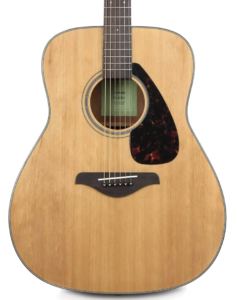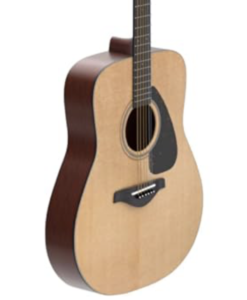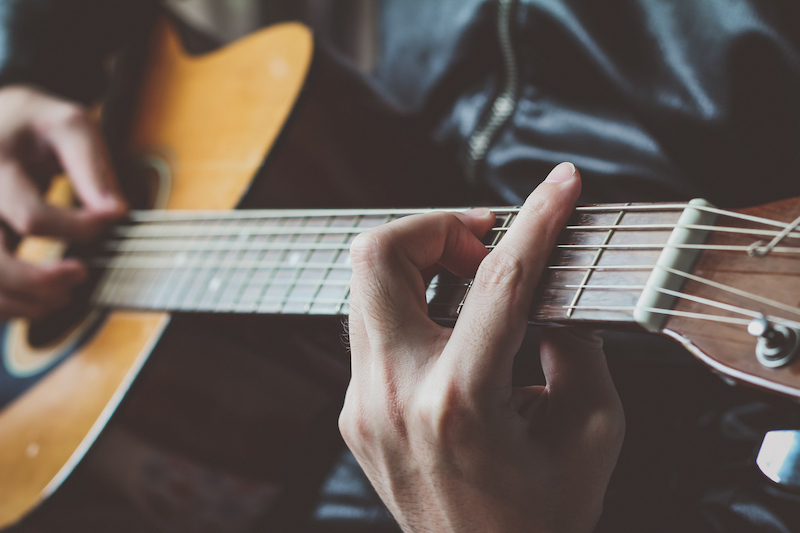The Yamaha FG800J acoustic is a guitar that is part of Yamaha’s FG series, which has been known for providing quality and affordability since its introduction in the 1960s.
The FG800 is often considered a solid choice for beginners and intermediate players alike. Here are some key features and details about the Yamaha FG800 Acoustic Guitar:
Body and Construction of the FG800J
 The Yamaha FG800 acoustic is known for its traditional dreadnought body shape, which contributes to its versatile sound suitable for various musical styles. Let’s delve into more details about the body and construction of the Yamaha FG800 acoustic guitar:
The Yamaha FG800 acoustic is known for its traditional dreadnought body shape, which contributes to its versatile sound suitable for various musical styles. Let’s delve into more details about the body and construction of the Yamaha FG800 acoustic guitar:
The FG800 features a classic dreadnought body shape, which is characterized by a large and deep body, squared shoulders, and a wide lower bout. This design results in a well-balanced sound with pronounced lows, mids, and highs.
The top of the FG800 is made from solid spruce. Solid wood tops are prized for their ability to resonate and mature over time, contributing to a richer and more nuanced tone. Spruce, in particular, is known for its bright and clear characteristics.
Back and Sides: The back and sides of the FG800 are typically constructed from nato or mahogany. These tonewoods contribute warmth to the guitar’s sound. Mahogany is known for its focused midrange and warm tone, while nato is often chosen for its balanced tonal qualities.
The FG800 utilizes Yamaha’s traditional scalloped bracing pattern. The scalloped bracing enhances the overall projection and resonance of the guitar by allowing the top to vibrate more freely. This contributes to a more dynamic and responsive instrument.
Also Read:
Yamaha CG-TA: TransAcoustic Classical Guitar
Best Guitar for Blues: 10 Great Instruments
Best Amp for Acoustic Guitar: 7 Great Options
Guitar Headstock: An Iconic Musical Signature
Classical Guitar vs Acoustic: Understanding the Differences
Neck Material
 The neck of the FG800 is made from nato or mahogany. These woods are commonly chosen for their stability and durability. The neck material can influence the feel and playability of the guitar.
The neck of the FG800 is made from nato or mahogany. These woods are commonly chosen for their stability and durability. The neck material can influence the feel and playability of the guitar.
The fingerboard is typically made from rosewood, providing a smooth and comfortable playing surface. Rosewood is known for its durability and contributes to a warm and balanced tone.
The FG800 has a standard scale length of 25.6 inches. The scale length affects the tension of the strings and can influence the playability of the guitar.
Bridge and Saddle of the FG800J
The bridge is usually made from rosewood, matching the fingerboard. The saddle, which sits on the bridge, is often made from urea. The combination of these materials contributes to good sustain and efficient tone transfer.
The nut, located at the top of the neck, is typically made from urea or a similar material. The nut width is 1.69 inches, providing sufficient spacing for fingerstyle playing.
The neck is made from nato or mahogany, offering stability and durability.
The fingerboard is typically made from rosewood, providing a smooth playing surface.
Technical Specifications
The Yamaha FG800J acoustic has a standard scale length of 25.6 inches, contributing to comfortable playability and string tension.
The guitar features Yamaha’s traditional scalloped bracing design, which enhances the overall projection and resonance of the instrument.
- The bridge is usually made from rosewood, matching the fingerboard.
- The saddle is often made from urea, contributing to good sustain and tone transfer.
- The nut is typically made from urea or a similar material.
- The nut width is 1.69 inches, providing sufficient spacing for fingerstyle playing.
Tuners
 The FG800 is equipped with die-cast chrome tuners, offering stable and reliable tuning.
The FG800 is equipped with die-cast chrome tuners, offering stable and reliable tuning.
The guitar is available in various finishes, including Natural, Sand Burst, and Tobacco Brown Sunburst.
The Yamaha FG800 is well known for its comfortable playability, making it suitable for both beginners and more experienced players.
Other Features of the FG800J
One of the standout features of the FG800 is its affordability. It provides a solid and reliable acoustic guitar option at a relatively budget-friendly price point.
The FG series from Yamaha has a long-standing reputation for being one of the most popular and trusted lines of acoustic guitars. The FG800 continues this tradition, maintaining the quality and consistency that players have come to expect from the series.
The versatile sound of the FG800 makes it suitable for various playing styles, from strumming to fingerpicking.
The Yamaha FG800 is often recommended for beginners due to its playability, affordability, and the reputation of the FG series. However, it is also appreciated by experienced players who seek a reliable and affordable acoustic guitar.
History of FG800J and Yamaha acoustic Guitars
 The history of Yamaha acoustic guitars dates back to the early 1960s, and Yamaha’s entry into the guitar market was marked by a commitment to producing high-quality instruments that were both affordable and accessible.
The history of Yamaha acoustic guitars dates back to the early 1960s, and Yamaha’s entry into the guitar market was marked by a commitment to producing high-quality instruments that were both affordable and accessible.
1960s – Entry into the Guitar Market: In the early 1960s, Yamaha decided to venture into the guitar manufacturing industry. The company’s initial goal was to create guitars that could compete with the quality of well-established Western brands but at a more affordable price point.
In 1966, Yamaha introduced the FG (Folk Guitar) series, marking a significant milestone in the company’s guitar manufacturing history. The FG series was designed to offer high-quality acoustic guitars at prices that were accessible to a broad range of musicians.
Yamaha was innovative in its approach to guitar design and construction. The company experimented with materials, bracing patterns, and manufacturing techniques to achieve the best possible sound and playability.
1970s – Global Recognition: By the 1970s, Yamaha acoustic guitars gained global recognition for their quality, craftsmanship, and affordability. The FG series, in particular, became immensely popular among players of various skill levels.
Yamaha continued to invest in research and development, incorporating advancements in technology to improve the quality and consistency of its acoustic guitars.
Modern Yamaha Acoustic Guitars
Over the years, Yamaha expanded its acoustic guitar lineup to include various body shapes, tonewoods, and features. This diversity allowed musicians to choose guitars that suited their playing styles and preferences.
Yamaha collaborated with renowned artists and introduced signature models, further enhancing the brand’s reputation. The collaboration with guitarist Michael Anthony in the 1980s for the Yamaha MSG Image line is an example of such partnerships.
Continued Innovation and Evolution: Yamaha has consistently introduced new models and updated existing ones to keep up with changing musical trends and player demands. Technological innovations, such as the use of advanced materials and electronics, have been incorporated into newer models.
Yamaha expanded its acoustic guitar offerings to include acoustic-electric models, featuring built-in pickups and preamp systems. This addition appealed to performers who wanted the flexibility to amplify their acoustic sound.
Yamaha remains a prominent player in the acoustic guitar market. The FG series continues to be a popular choice, and Yamaha offers a wide range of acoustic guitars catering to various playing styles and skill levels.
The history of Yamaha acoustic guitars is marked by a dedication to providing accessible and high-quality instruments for musicians worldwide. The FG series, in particular, has played a significant role in shaping Yamaha’s reputation in the acoustic guitar market, making it one of the most respected and trusted brands in the industry.
